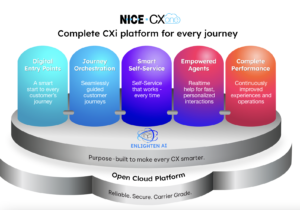 Coining a new term of art for the cloud-based IT infrastructure community is always a challenge. Rightfully so. At Opus Research, we’re partial to “Conversational Cloud”, as a concept that captures the consumption model executives in charge of IT, Contact Centers or “Digital Transformation” pursue as they turn to cloud-based solution providers that enable them to migrate legacy systems off-premises, while adding just the right amount “AI”. The core menu of capabilities that support their objectives include advanced analytics (to extract insights from conversational between and among prospects, customers and employees), natural language understanding (to recognize the context of each conversation), machine learning (to provide for constant improvement of results).
Coining a new term of art for the cloud-based IT infrastructure community is always a challenge. Rightfully so. At Opus Research, we’re partial to “Conversational Cloud”, as a concept that captures the consumption model executives in charge of IT, Contact Centers or “Digital Transformation” pursue as they turn to cloud-based solution providers that enable them to migrate legacy systems off-premises, while adding just the right amount “AI”. The core menu of capabilities that support their objectives include advanced analytics (to extract insights from conversational between and among prospects, customers and employees), natural language understanding (to recognize the context of each conversation), machine learning (to provide for constant improvement of results).
At its recent Analyst Summit, NICE Ltd trotted out a term of its own, “Suiteform” which it expects to become a de facto standard for combining the suite of services described above into a software “platform”, which is a term that most often refers to the underlying operating system (OS) or framework that can run multiple, purpose-driven applications. NICE refers to these as CXi, the abbreviation of “Customer Experience interactions”. Their purpose is to support the sort of “inter-app workflows” (quoting NICE CEO Barak Eilam) that are required to support digital self-service and employee productivity over time and across every channel and device that customers, agents and departmental employees put to use.
“Suiteform” or Splatform? It’s all in the Execution
One nice aspect of “Suiteform” as a name is that it is a homophone for “Sweet Form”. Following a “you catch more flies with honey” tactic, the idea is to lure a large community of developers into an ecosystem of cloud-native applications, tools and infrastructure. This was the foundational value statement for the prototype Communications Platform as a Service (CPaaS) specialist, Voxeo and Twilio, about a decade ago as they conceived of what Opus Research called “The Telco API” in this report from a decade ago.
NICE is pursuing a packaging and pricing strategy that integrates its contact center solutions (CXOne) with a range of applications and workflows that are informed by its brand of Conversational AI, called Enlighten. Its buyers invest in a comprehensive suite that features predictable billing (based largely on the number of agent seats but adjusted to account for additional applications. They claim that it provides for predictable bills, zero-cost migrations, guaranteed SLAs and the ability to toggle applications on or off an an as needed basis. All of these actions are supported by “highly-specialized, yet unified” sales and support personnel.
The alternative to a comprehensive, purpose-driven Suiteform, is a less advantageous approach that is more like a “Splatform”, or haphazard array of native and third-party applications in a marketplace that is loosely coupled to a core CCaaS offering. Over the past five years or the path to Conversational AI has been largely unpaved with different departments launching pursuing their own “bot strategy” Without reference to any specific CXOne/Enlighten competitors, the problems presented by such an approach are made manifest by the fact that it is commonplace for large enterprises to have dozens of solution providers offering everything from chatbots/voicebots,
By organizing a suite of services into a unified platform, NICE addresses the first-order needs of enterprises that want to address the full spectrum of challenges involved with digital CX. It starts with providing more responsive self-service by recognizing each customer’s intent based on knowing who they are, where they’ve been and the words they use in chat or over the phone. Then it involves being more proactive and pre-emptive in rapidly addressing those needs, employing automated resources as required. In NICE’s case, the proactive elements (largely outbound alerts and reminders) are supported by the integration of ContactEngine. Pre-emption is accomplished natively by relying on SEO-enhanced understanding that was acquired through Mindtouch. Complex automation is handled through an OEM arrangement with Intelligent Virtual Assistant specialist Amelia, dubbed SmartAssist. Plus, tools and resources to create or orchestrate self-service bots are accomplished through the NICE Virtual Agent Hub or the NICE Agent Assist Hub, respectively.
The suiteform approach also mitigates much of the pain, effort and expense associated with configuring systems that need to accommodate complex workflows and APIs associated with identity management, intelligent transfers with context and real-time access to the back-end systems needed to inform interactions. None of these efforts are simple, but the complexities can be better addressed when the suite of services are integrated into a single platform.
Categories: Conversational Intelligence, Intelligent Assistants, Articles

 2025 Conversational AI Intelliview: Decision-Makers Guide to Self-Service & Enterprise Intelligent Assistants
2025 Conversational AI Intelliview: Decision-Makers Guide to Self-Service & Enterprise Intelligent Assistants  Talk to the Web: How NLWeb Opens Conversational Access to Site Content
Talk to the Web: How NLWeb Opens Conversational Access to Site Content  Voice AI Agents Redefine CX: Trends, ROI, and Strategies for 2025
Voice AI Agents Redefine CX: Trends, ROI, and Strategies for 2025  Why Voice AI Is Foundational for Enterprise Innovation (Webinar)
Why Voice AI Is Foundational for Enterprise Innovation (Webinar)